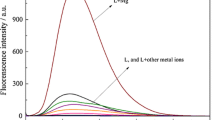Abstract
A new bis-Schiff base ligand, N,N′-bis-(4-N-aminothiourea-2-amylidene)-4,4′-diaminodiphenyl sulfone (ARADS), was synthesized. The solutions of its complex with Eu3+ in DMF can emit the intrinsic fluorescence of Eu3+. The fluorescence intensity of the complex was enhanced 20–30-fold in the presence of EDTA (or alum). The influence of seven kinds of solvents (DMF, CH3CN, THF, acetone, CH3OH, C2H5OH, and DMSO) on the intensity of fluorescence was studied. The results showed that the Eu3+-ARADS-EDTA (or alum) system emits its strongest fluorescence in DMF. Thus, the system can be used to develop a new method for the determination of europium(III). The excitation and emission wavelengths are 395 and 615 nm, respectively. Under optimal conditions, the fluorescence intensities vary linearly with the concentration of Eu3+ in the range 6.0 × 10−10−5.2 × 10−5 mol/L, with a detection limit of 5.0 × 10−10 mol/L. The interference from some rare earth metals and other inorganic ions are described. The method is a selective, sensitive, rapid, and simple analytical procedure for the determination of europium(III) in high-purity yttrium oxide and synthetic samples. The mechanism of fluorescence enhancement was also studied.
Similar content being viewed by others
REFERENCES
Dagnall, R.M., Smith, R., and West, T.S., Analyst, 1967, vol. 92, p. 358.
Du, X.Z., Gao, J.Z., Xie, Q., and Kang, J.W., Talanta, 1994, vol. 41, no.2, p. 201.
Panigrahi, B.S., Spectrochim. Acta, 2000, vol. 56, p. 1337.
Qin, W.W., Lui, W.S., and Tan, M.Y., Anal. Chim. Acta, 2002, vol. 468, p. 287.
Zhao, J.Z., Zhao, B., Liu, J.Z., et al., Spectrochim. Acta, 2001, vol. 57, p. 149.
You, X.Z., Men, Q.J., and Han, W.S., Higher Educ. Press, 2000, vol. 8, p. 17.
Chen, Q.Y. and Luo, Q.H., Huaxue Tongbao, 2002, vol. 9, p. 601.
Taketatsu, T. and Sato, A., Anal. Chim. Acta, 1979, vol. 108, p. 429.
Yang, W., Mo, Z.L., Teng, X.L., et al., Talanta, 1998, vol. 46, no.4, p. 527.
Yang, W., Mo, Z.L., Teng, X.L., et al., Analyst, 1998, vol. 123, p. 1745.
Author information
Authors and Affiliations
Additional information
__________
From Zhurnal Analiticheskoi Khimii, Vol. 60, No. 4, 2005, pp. 372–377.
Original English Text Copyright © 2005 by Tianlin Yang, Wenwu Qin, and Weisheng Liu.
The article was submitted by the authors in English.
Rights and permissions
About this article
Cite this article
Yang, T., Qin, W. & Liu, W. Determination of trace europium(III) based on a new fluorescence enhancement system of europium(III) with N,N′-bis-(4-N-aminothiourea-2-amylidene)-4,4′-diaminodiphenyl sulfone by EDTA or alumin in N,N-dimethylformamide. J Anal Chem 60, 325–329 (2005). https://doi.org/10.1007/s10809-005-0092-z
Received:
Accepted:
Issue Date:
DOI: https://doi.org/10.1007/s10809-005-0092-z




